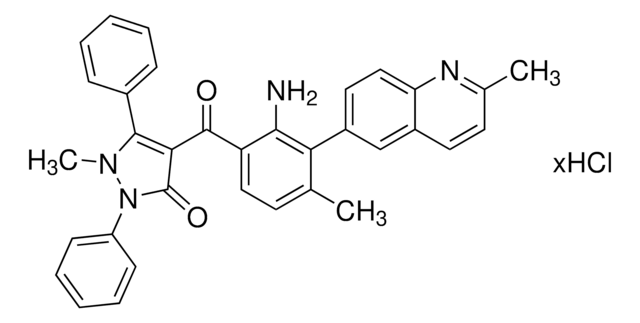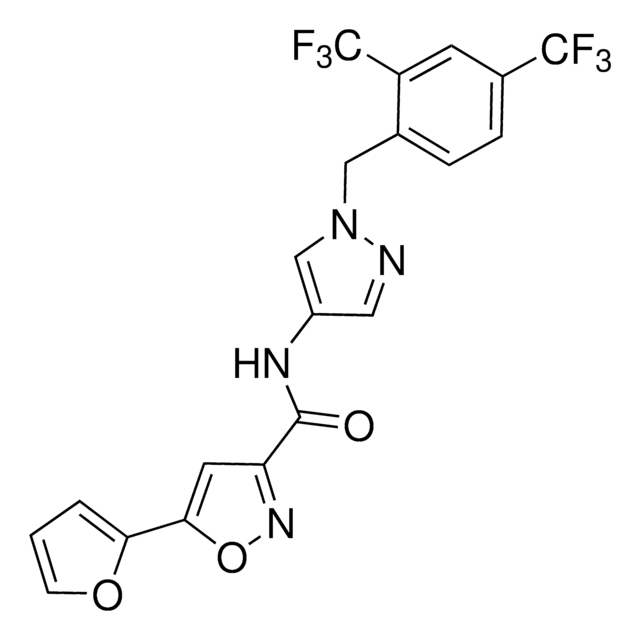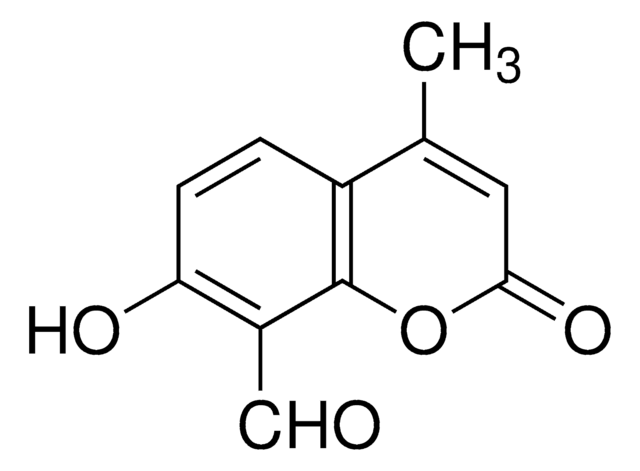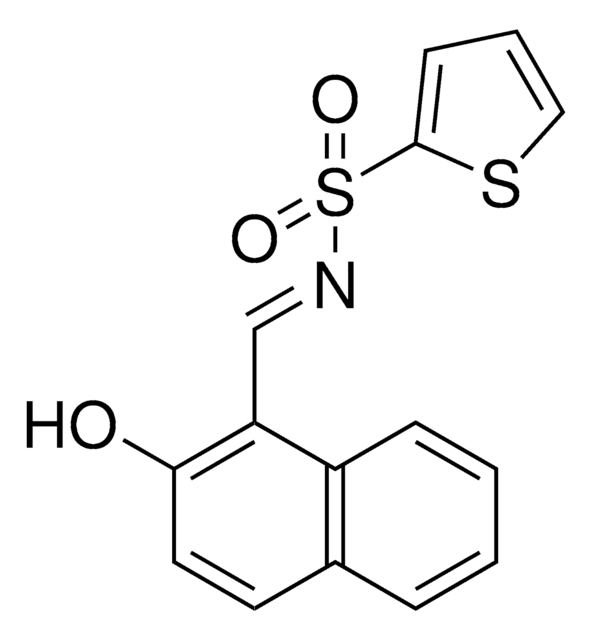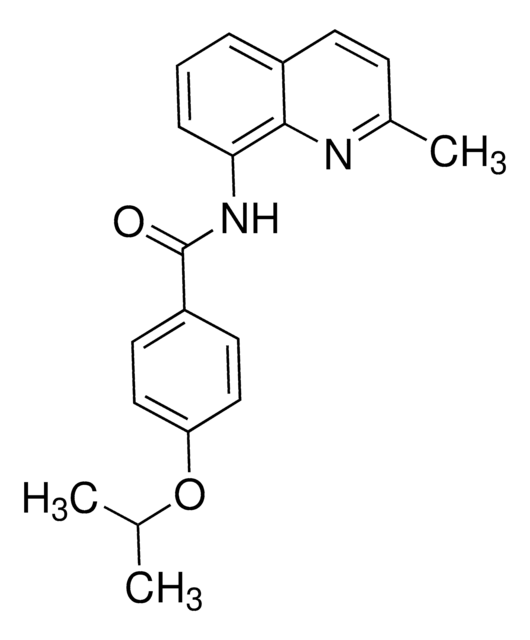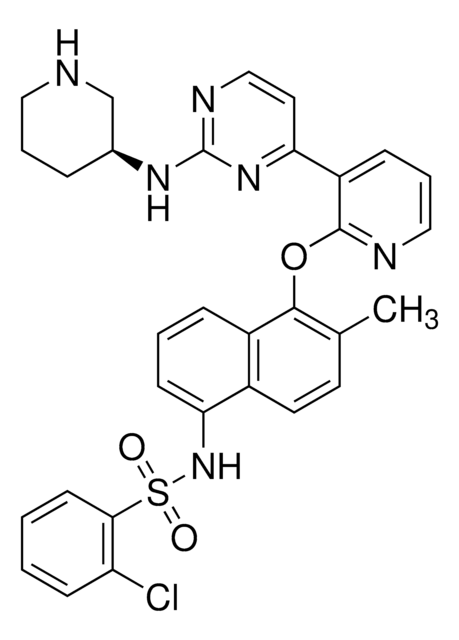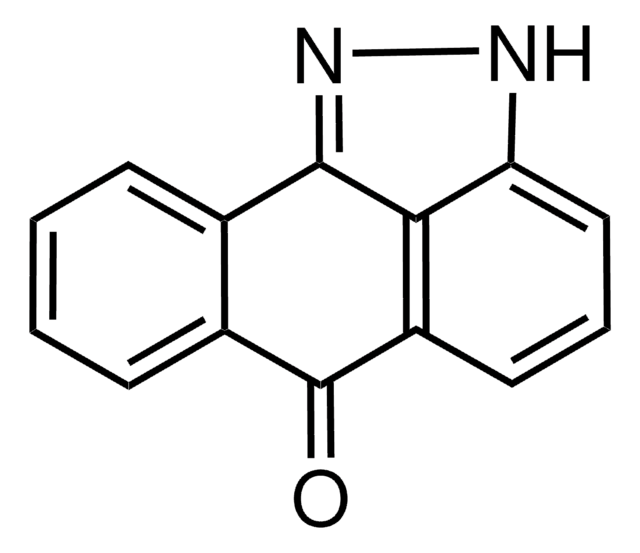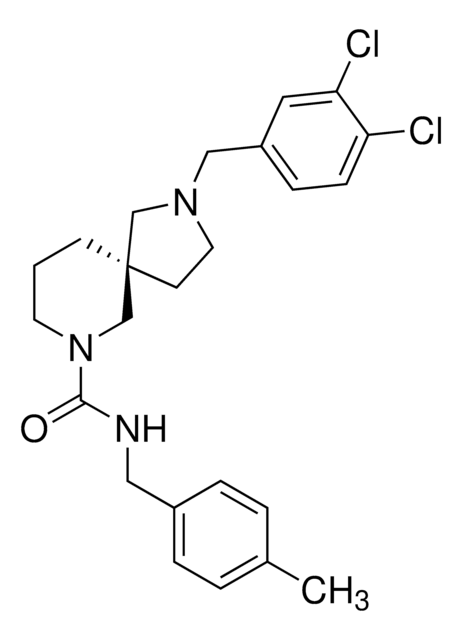推荐产品
化驗
≥97% (HPLC)
形狀
powder
顏色
white to beige
溶解度
DMSO: 2 mg/mL, clear
儲存溫度
−20°C
SMILES 字串
C1(NC2=CC(C3CC3)=NN2)=CC=NC(NC4=CC=C(N=CN5)C5=C4)=N1
InChI
1S/C17H16N8/c1-2-10(1)13-8-16(25-24-13)22-15-5-6-18-17(23-15)21-11-3-4-12-14(7-11)20-9-19-12/h3-10H,1-2H2,(H,19,20)(H3,18,21,22,23,24,25)
InChI 密鑰
WJNBSTLIALIIEW-UHFFFAOYSA-N
一般說明
APY29 is considered as a type I kinase inhibitor of inositol requiring kinase enzyme 1 α (IRE1α).
生化/生理作用
APY29 has the ability to enhance inositol requiring kinase enzyme 1 α (IRE1α) (P830L)′s oligomeric state to rescue RNase activity.
APY29 is a small molecule that inhibits the kinase activity of IRE1α (in vitro autophosphorylation IC50 = 280 nM) by targeting its active site ATP-binding pocket, while simultaneously acting as an allosteric activator of IRE1α RNase activity (EC50 = 460 nM) by keeping the active site in an open conformation. When applied 1 hr prior to stress induction by 4-hr 6 nM thapsigargin treatment, APY29 significantly potentiates stress-induced unfolded protein response (UPR) in rat insulinoma INS-1 cultures (XBP1 mRNA processing induction = 54% without vs. 78% with 1-hr 3 μM APY29 pretreatment).
儲存類別代碼
11 - Combustible Solids
水污染物質分類(WGK)
WGK 3
閃點(°F)
Not applicable
閃點(°C)
Not applicable
Allosteric inhibition of the IRE1alpha RNase preserves cell viability and function during endoplasmic reticulum stress
Ghosh R, et al.
Cell, 158(3), 534-548 (2014)
Alexei V Korennykh et al.
Nature, 457(7230), 687-693 (2008-12-17)
Aberrant folding of proteins in the endoplasmic reticulum activates the bifunctional transmembrane kinase/endoribonuclease Ire1. Ire1 excises an intron from HAC1 messenger RNA in yeasts and Xbp1 messenger RNA in metozoans encoding homologous transcription factors. This non-conventional mRNA splicing event initiates
Alexei V Korennykh et al.
BMC biology, 9, 47-47 (2011-07-07)
The unfolded protein response (UPR) controls the protein folding capacity of the endoplasmic reticulum (ER). Central to this signaling pathway is the ER-resident bifunctional transmembrane kinase/endoribonuclease Ire1. The endoribonuclease (RNase) domain of Ire1 initiates a non-conventional mRNA splicing reaction, leading
Rajarshi Ghosh et al.
Cell, 158(3), 534-548 (2014-07-16)
Depending on endoplasmic reticulum (ER) stress levels, the ER transmembrane multidomain protein IRE1α promotes either adaptation or apoptosis. Unfolded ER proteins cause IRE1α lumenal domain homo-oligomerization, inducing trans autophosphorylation that further drives homo-oligomerization of its cytosolic kinase/endoribonuclease (RNase) domains to
Likun Wang et al.
Nature chemical biology, 8(12), 982-989 (2012-10-23)
Under endoplasmic reticulum stress, unfolded protein accumulation leads to activation of the endoplasmic reticulum transmembrane kinase/endoRNase (RNase) IRE1α. IRE1α oligomerizes, autophosphorylates and initiates splicing of XBP1 mRNA, thus triggering the unfolded protein response (UPR). Here we show that IRE1α's kinase-controlled
我们的科学家团队拥有各种研究领域经验,包括生命科学、材料科学、化学合成、色谱、分析及许多其他领域.
联系技术服务部门